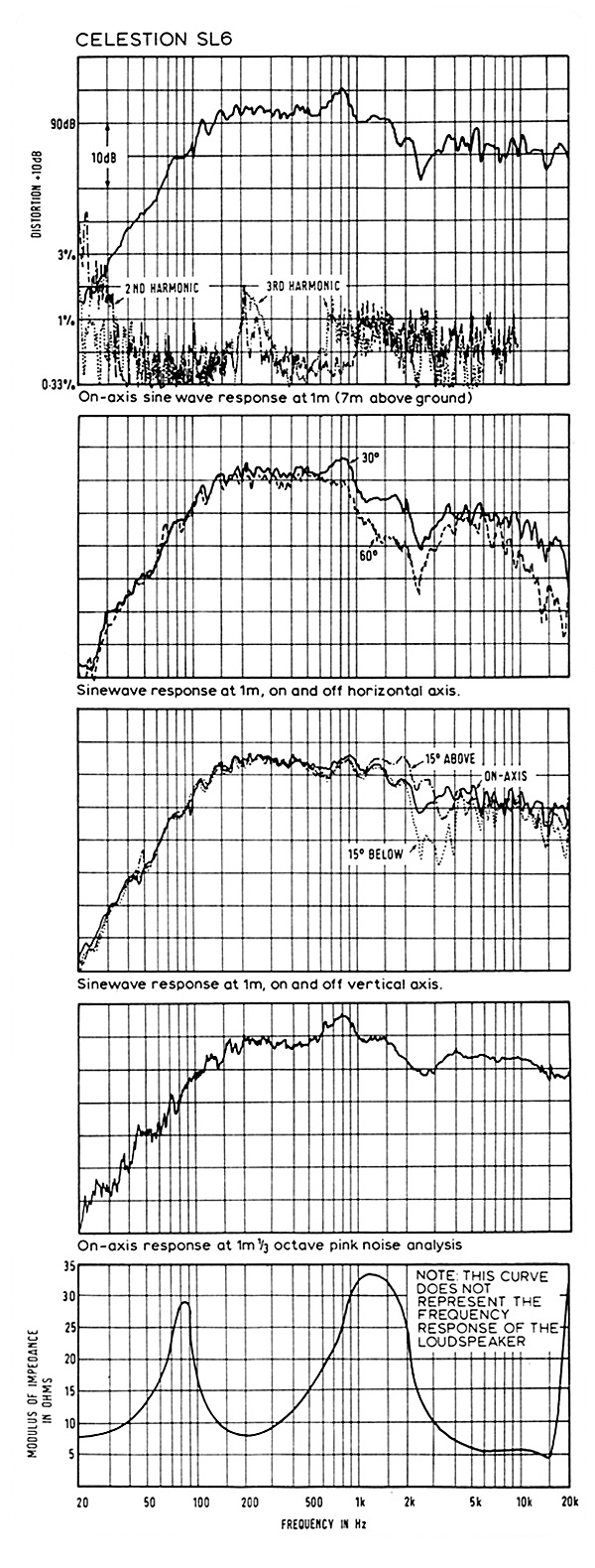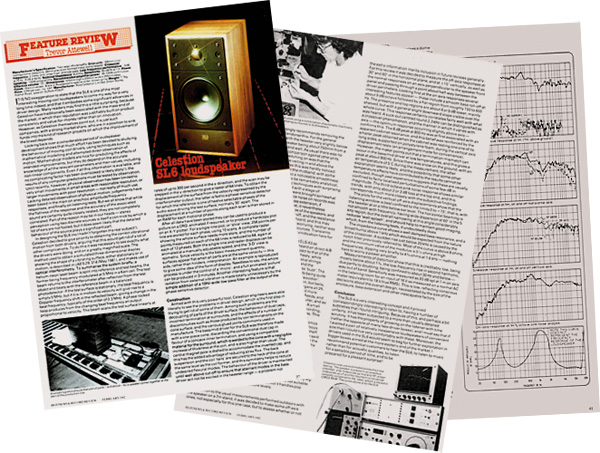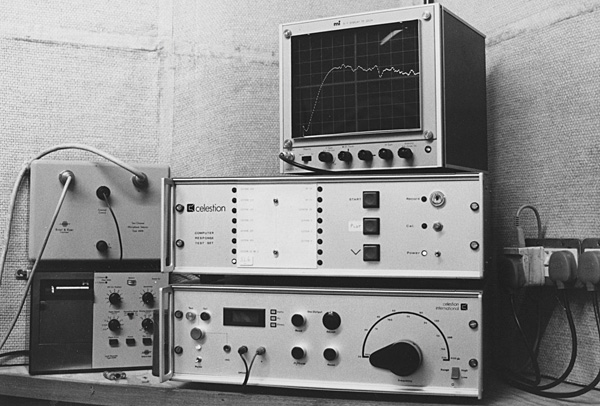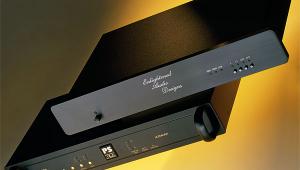Celestion SL6 Loudspeaker Page 2
The construction ensures good thermal dissipation, and the unit can withstand 50W continuous input! It has an 'oil-can' mode (centre out of phase with edge) just above 20kHz, and this is taken care of by a combination of notch and low-pass filters in the crossover. Finally, the bass resonance is at 1.4kHz, and is electromechanically damped by the metal former acting as a short-circuited turn in the magnet gap.
Well Behaved
Having seen some of the results from the interferometer on both these units, I can vouch for the fact that they are quite remarkably well behaved over the relevant audio bands. Nobody – at least, no physicist – is likely to disagree with the basic premise that the first step towards producing an accurate loudspeaker is to secure the simple and controlled behaviour of each driver. And this has certainly been achieved in the Celestion SL6.

The completed unit was styled, without compromising essential design features, by Allen Boothroyd, as also was the 'consumer' pack supplied with it, comprising spade terminations, banana plugs, stick-on feet and owner manual in a box screen-printed in brown on bronze.
Fillets And Filling
The rectangular cabinet, of pleasing proportions, is made from 19mm particle board with a slightly inset front panel. The sides, top and bottom are veneered, and so also are the front edges of the four sides. The panel and back of the speaker are black. The two longer sides are reinforced by square fillets of particle board, and all sides and the back carry damping panels. Further damping is provided by a loose filling of bonded acetate fibre.
The crossover design has been simplified by the control exercised over the driver roll-offs, and consists of four elements. These, and the filters, are realised with nine components, of which three are generously rated capacitors wired in parallel. All components are on a PCB secured by the stems of the input terminals, which are recessed into the rear panel and have drillings for 4mm banana plugs.

The bass/mid driver sits in a countersink in the front panel, and is clamped by a rectangular trim plate. This has a circular hole in its middle with a vertical edge to grip the outer rim of the driver, and is fixed by four Allen screws to the main panel. The tweeter is bolted to a matching rectangular plate at the top of the cabinet, and the dome is protected by horizontal metal strips.
Both these panels are ribbed vertically, and this is said to reduce diffraction at higher frequencies. The bottom of the front panel, which is not occupied by the metal plate, is covered in plastic. The grille covers the whole of the front of the speaker, and is a wood frame covered in brown material, and held in place by four plastic pegs. Constructional standards throughout are excellent, and the overall appearance of the SL6 is attractive, especially considering the necessarily rather basic shape of nearly all loudspeaker enclosures.
![]() Sound Quality
Sound Quality
In the owner's manual, Celestion recommends placing the speaker with the tweeter at about ear level, though it subsequently suggests that if a stand is used it should be about 15in high. The two positions are not compatible, and I found the former preferable. Also, keep the speakers away from walls, and particularly corners, if you are seeking the best available performance.
The manufacturer also strongly recommends removing the grille when listening, and I would endorse this. For the general listening test the SL6s were used with the tweeter very slightly below ear level (roughly 150mm), each speaker being about 750mm from a side wall and just over 1m from the end wall.
The immediate impression was that the speakers were a little dull, due to some veiling in and above the presence region, but after a few minutes this was hardly noticed. Although the balance seemed to favour the midband, with some chestiness in male voices, there was also a noticeable smoothness to the sound. The speakers were found to be remarkably analytical, too, showing up such things as recording techniques with surprising clarity.
The stereo image was well defined with a stage of considerable depth, recorded ambiences were brought somewhat forward, and surface noise on records was nowhere near so annoying. Although the bass extension, if concentrated upon, was not particularly great, it nevertheless seemed to have a surprising weight for the size of the speakers, and this was attributed to the cleanness of the roll-off, and the resistance to doubling. A slight midband coloration was heard, and this may originate in the cabinet, but at no time was this worrying. Neither was one ever aware of the two speakers as discrete sources. Transients were crisp, and without hangover, the presentation overall giving a clear vindication for the design method and philosophy.
Direct Comparison
In our usual comparative tests against the Quad ELS-63, the following detailed differences were heard on direct A/B comparison, quoting the sound of the SL6 with respect to that of the Quads. Male voices were slightly darker and more chesty, while female voices had less edge and breathiness. Orchestral strings were less sharp-edged, the cello being a little duller and the double-bass, though generally very similar, having less 'buzz'.

Meanwhile, the brass section were all a trifle less bright, the woodwinds being quite similar except for the flute, which sounded somewhat 'woodier'. Tymps and snare drums had just a trace of mid coloration, but bells, glockenspiel and xylophone were very similar. In pipe organs, all 2ft stops and above were reduced a little in level and sounded more ethereal, while 4ft stops were more emphasised.
A small but interesting difference was heard in a cathedral choral recording, in which the SL6 shifted the balance towards the boys' voices. This seemed out of step with other differences noted above, but is possibly due to a slight reduction in the level of the male harmonics relative to their fundamental, and not equally applicable to the boys. This would confirm a previous suspicion of a depressed treble shelf.
It can be said that the differences were clear, but whereas familiarity with the test material and the recording locations left me in no doubt that the ESL-63 was telling the truth, this would not have been obvious to anyone hearing both versions for the first time.
Using a 100W-per-channel amp, the sound level obtainable from a pair of Celestion SL6s was certainly adequate for all normal domestic purposes, and higher powers up to 200W were withstood without any problem, though the manufacturer does not recommend such treatment.
In all cases the amplifier clipped before the drivers bottomed, and it seems likely that the power rating is conservative, but this is only my suggestion, not a statement of fact. The loudspeaker is not suitable for use at disco levels, nor is it intended to be, but it handles pop music well at more normally acceptable levels.
Conclusion
The Celestion SL6 is not only a very interesting concept but also proved interesting to listen to, having a number of subtleties that I found intriguing. It has the property of growing on the listener with time (rather the opposite of many two-driver boxes), and I must say that if I wanted a pair of relatively inexpensive loudspeakers of convenient size then I could live very comfortably with these.
Moreover, the drivers used in the SL6 would seem to beg for further exploitation in bigger boxes aimed at the more esoteric end of the market. I recommend potential customers to hear the SL6, to listen to music rather than for acoustic qualities, to listen for a sensible period of time, and to be prepared for a pleasant surprise!























































